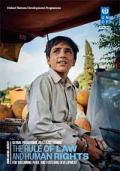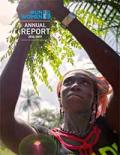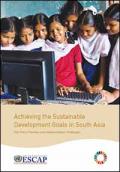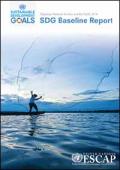What's New
Displaying results 1851 - 1860 of 4914

Resource | Publications,
Since 2008, the UNDP Global Programme on Strengthening the Rule of Law and Human Rights for Sustaining Peace and Fostering Development (previously known as Strengthening the Rule of Law in Crisis-Affected and Fragile Situations) has provided rule of law support to over 40 crisis-affected countries. The programme has been a driving force in improving the delivery of UNDP’s assistance and in pioneering joint UN approaches to supporting the rule of law. The 2012 establishment of the Global Focal Point for Police, Justice, and Corrections Areas in the Rule of Law in Post-Conflict and Other Crisis Situations is a notable development in this regard.
This Annual Report provides an overview of the first year of implementation of Phase III of the Global Programme (2016–2020) – highlighting the political and human rights dimensions of the rule of law and how our support contributes to sustaining peace. Part I, Year in Review, reflects on international policy developments affecting rule of law assistance and provides key country-level results achieved through the Global Programme in 2016. Part II, Country Profiles, presents an analysis of our engagement in 34 countries affected by crisis, conflict, and fragility. Lastly, Part III, provides detailed financial information on the Global Programme.

Resource | Publications,
This report showcases the many ways in which we support work at country and global level to turn the aims of the 2030 Agenda for Sustainable Development into results for women and girls worldwide, working closely with Member States and a wide range of partners to realize rights and build resilience.
Around the world, empowered women are achieving visible progress. We know the power of positive role modelling; how vital it is for girls growing up to see the success of their contemporaries, and through education, experience and example, for it to come within their grasp. In 2016, the first year of implementing the Sustainable Development Goals, we supported women to claim their right to equal treatment under the law, to gain elected office, to draw on the power of innovation and technology, and to become leaders through sports, among many other initiatives. We also supported civil society and women’s rights activists to inform and influence crucial policy discussions.

Resource | Publications,
Regionally in the Asia and Pacific, adolescents and young key populations are disproportionately affected by HIV/AIDS and yet are often excluded from policy, program and funding decisions at national, regional and global levels. This exclusion contributes to them being severely underserved by the HIV response. We believe the role of most affected communities in the HIV epidemic points to the crucial importance of their meaningful engagement in making policy and funding decisions. Young Key Populations are no exception.
This documentation was produced by Youth LEAD, The Regional Network of Young Key Population in Asia and Pacific as a showcase of our support and interventions to Young Key Populations from Indonesia, Pakistan and Vietnam who applied the Global Fund funding request as the first window applicants beginning from late 2016 to early 2017.

Resource | Guidelines,
Surveillance, when conducted ethically, is the foundation for programs to promote human well-being at the population level. It can contribute to reducing inequalities: pockets of suffering that are unfair, unjust and preventable cannot be addressed if they are not first made visible. But surveillance is not without risks for participants and sometimes poses ethical dilemmas. Issues about privacy, autonomy, equity, and the common good need to be considered and balanced, and knowing how to do so can be challenging in practice.
The WHO Guidelines on Ethical Issues in Public Health Surveillance is the first international framework of its kind, it fills an important gap. The goal of the guideline development project was to to help policymakers and practitioners navigate the ethical issues presented by public health surveillance. This document outlines 17 ethical guidelines that can assist everyone involved in public health surveillance, including officials in government agencies, health workers, NGOs and the private sector.

Resource | Tools,
Around the world, national health authorities and programmes are striving to ensure that “no one is left behind”, in keeping with this cross-cutting principle in the Sustainable Development Goals (SDGs). The Innov8 approach for reviewing national health programmes to leave no one behind (the Innov8 approach) aims to support these efforts. It also supports the progressive realization of universal health coverage and the right to health.
As the partnering publication to the aforementioned Innov8 Technical Handbook, this Facilitator's Manual is meant for persons conducting the capacity-building workshops of Innov8 applications.
Depending on the type of national and programmatic application, the World Health Organization (WHO)
suggests that at least three capacity-building workshops be conducted for/with the national
review team. One workshop is convened in each of the consecutive review process phases, which we
describe here as sensitization, review and redesign.

Resource | Publications,
In 2000 the National Adolescent Sexual and Reproductive Health Strategy was developed by the Family Health Division (FHD) of the Ministry of Health and Population (MoHP). Following the strategy, in 2007 the implementation guidelines for ASRH were developed, and in 2010 the National Adolescent Sexual and Reproductive Health Programme was developed by FHD. In addition National Adolescent Friendly Health Services (AFHS) standards and actions was developed as required at the programmatic and facility level.
During the last quarter of 2015, a review was conducted to ascertain how the national Adolescent Sexual Reproductive Health Programme of Nepal could better address equity, gender, human rights and social determinants of health, hence working to ensure that “no adolescent is left behind”. This review was led by the Family Health Division of the Ministry of Health and Population (MoHP) of Nepal, with support from the World Health Organization (WHO) and Health Research and Social Development Forum (HERD), and in conjunction with other members of an interdisciplinary review team. This report is a description of the review team’s analysis, which applied a review methodology.

Resource | Guidelines,
The 2017 WHO Consolidated guidelines on person-centred HIV patient monitoring and case surveillance aim to help countries to implement WHO strategic information indicators for HIV (1) and WHO guidance on the use of antiretroviral drugs for HIV treatment (2) into routine HIV patient monitoring and health information systems.

Resource | Guidelines,
In 2014, the World Health Organization (WHO) released the first edition of the Global guidance on criteria and processes for validation: elimination of mother-to-child transmission of HIV and syphilis (EMTCT). In 2015, the Global Validation Advisory Committee for EMTCT was established and, as of October 2017, eleven countries or territories have been validated for achieving elimination of mother-to-child transmission (MTCT) of HIV and/or syphilis as a public health problem. This second edition of the EMTCT global validation guidance document captures the learning from these validation efforts to date, and reflects WHO’s commitment to the global effort to eliminate MTCT of HIV and syphilis, and expand the capacity of maternal and child health services to address vertical transmission of other communicable diseases.
This second edition of the EMTCT global validation guidance document provides standardized processes and consensus-developed criteria to validate EMTCT of HIV and syphilis, and to recognize high-HIV burden countries that have made significant progress on the path to elimination. The guidance places strong emphasis on country-led accountability, rigorous analysis, intensive programme assessment and multilevel collaboration, including the involvement of communities of women living with HIV.

Resource | Publications,
This Report provides a timely analysis of the SDG outlook in the subregion. It begins by discussing the MDG achievements and the lessons that can be drawn from the MDG experience in the subregion. From here, the Report then provides an action plan for accelerating SDG achievement. In particular, the Report focuses on seven key policy priorities, taking cognizance of the relationships between the SDGs goals and targets which need to be catalyzed by inclusive and sustainable transformation policies (Section 3). The Report then discusses the subregional and regional institutional arrangements required for SDG implementation (Section 4), and highlights the implementation challenges and measures needed to address the capacity gaps (Section 5). The Report concludes with remarks on South Asia’s stake in the global achievement of the SDGs.

Resource | Publications,
The Asia-Pacific Sustainable Development Goals (SDG) Baseline Report introduces an innovative regional progress measurement methodology. The report estimates objective and feasible target values for the region. It makes use of available data to establish a baseline and assess the gaps which need to be closed if the SDGs are to be achieved by 2030. The analysis uses national values for 30 per cent of the proposed global SDG indicators to assess regional achievements for each SDG in the baseline year 2015. It applies a subset of these indicators to illustrate the progress made since 2000 and progress needed to meet the 2030 targets.
The report presents the SDG baseline for the Asia and the Pacific both at the regional and sub-regional level for selected targets of each SDG. It uses the latest country data and supplementary statistical information aligned to the proposed global indicators.





